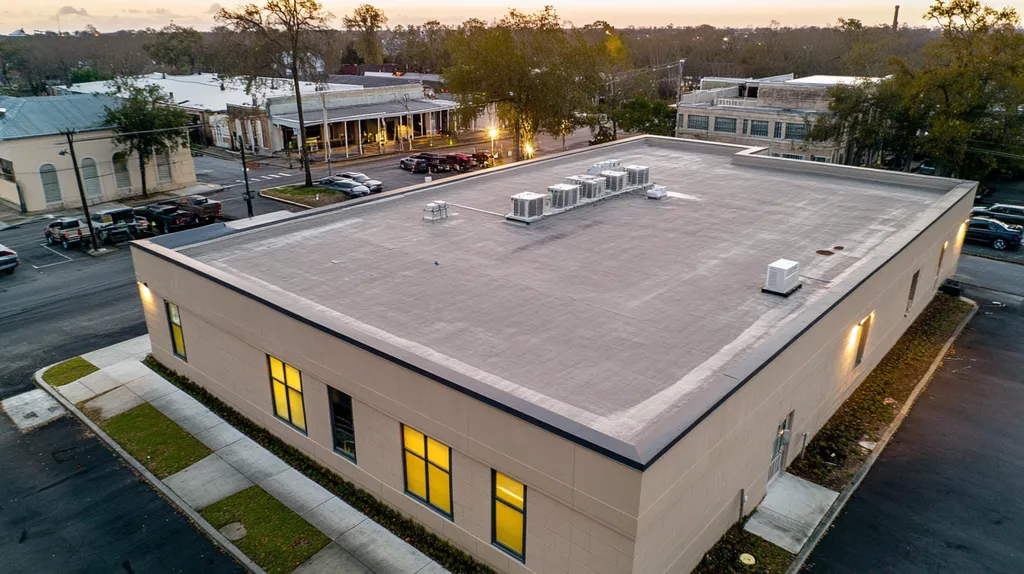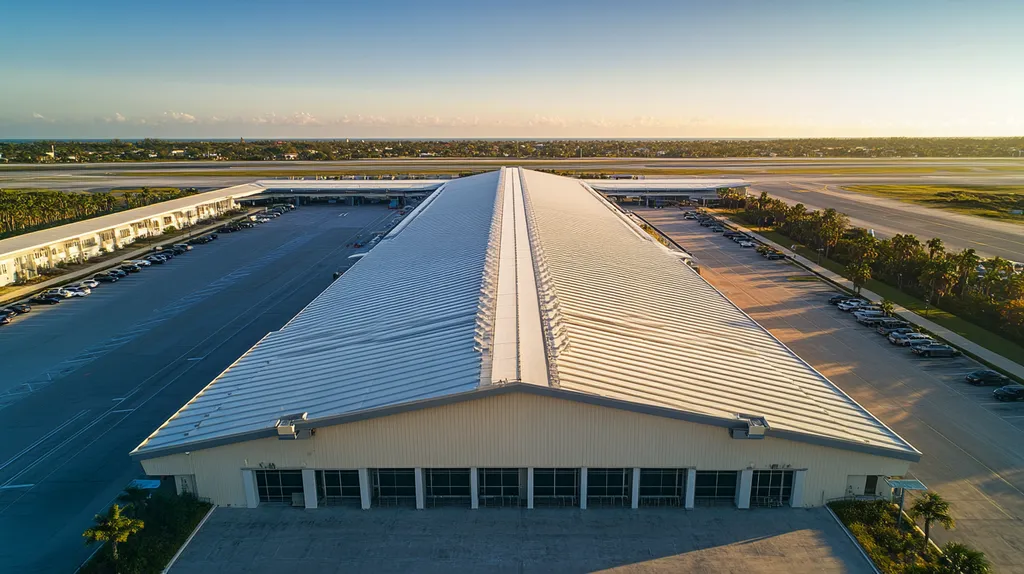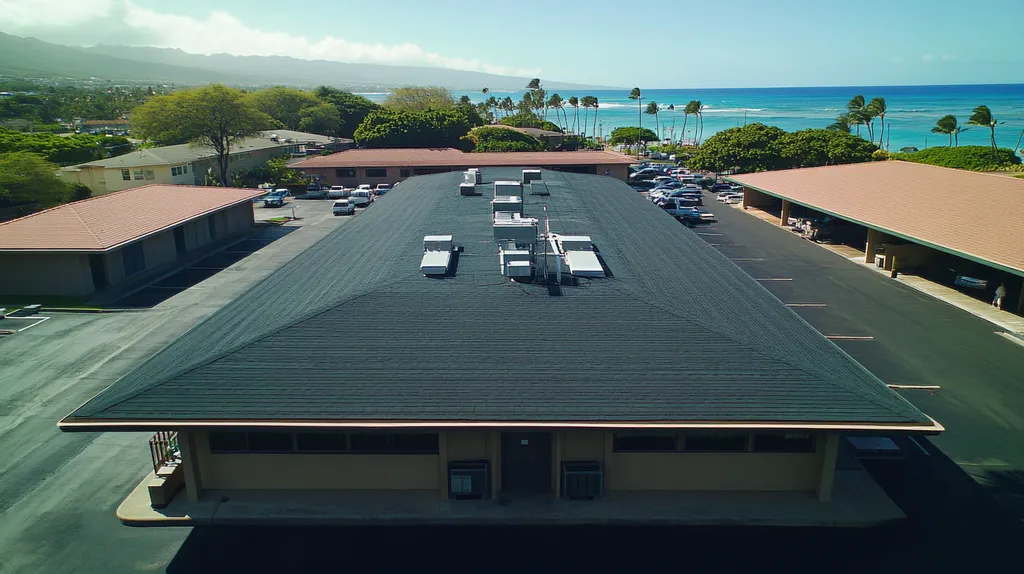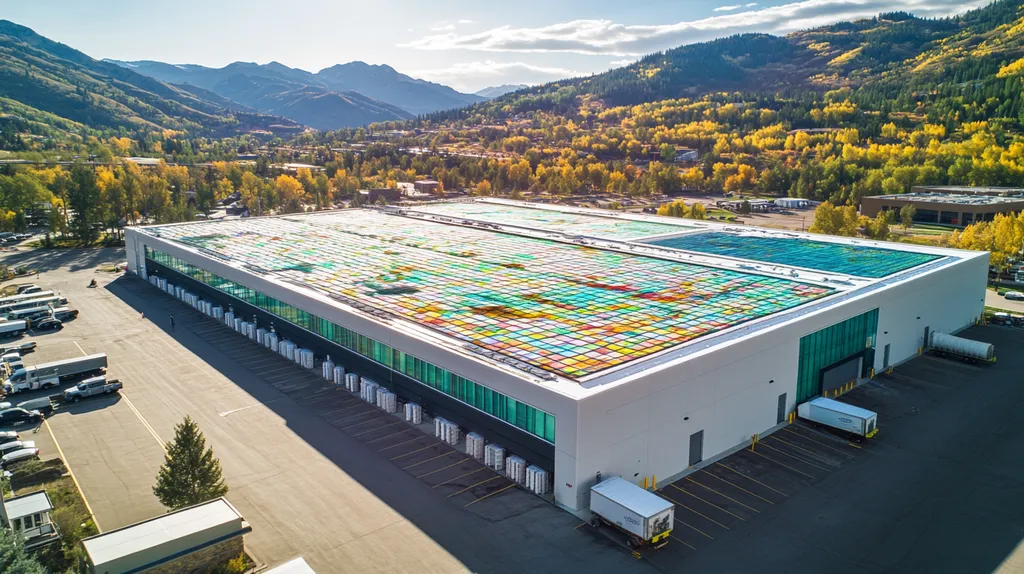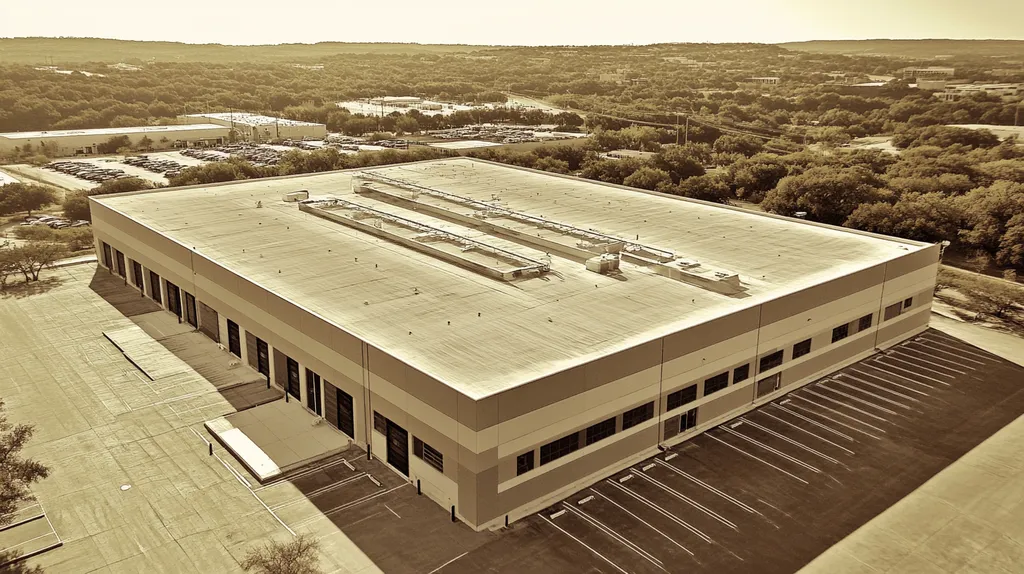Commercial roofs silently deteriorate every day, with over 40% of premature failures stemming from undetected aging signs. For property owners and facility managers, these oversights result in millions of dollars in preventable damage annually.
Understanding the warning signals – from membrane degradation to structural fatigue – can mean the difference between minor repairs and catastrophic failure.
This comprehensive guide examines the critical indicators of commercial roof aging, breaking down the essential components, inspection methods, and maintenance strategies that protect this vital business asset.
SECTION 1: FUNDAMENTAL CONCEPTS
Recognizing the signs of aging on a commercial roof is not just beneficial—it’s essential. Over 40% of commercial roofing failures stem from overlooking these vital indicators. Early detection of issues can prevent costly repairs and safeguard the building’s integrity. This section will delve into roof lifespan expectations, explore various commercial roofing materials, and examine how climate conditions affect roof longevity.
Roof Lifespan and Expectations
The lifespan of a commercial roof can range significantly based on the materials used and the level of maintenance provided. Typically, a well-maintained roof can last between 15 to 30 years. However, ignoring signs of aging can result in premature failures, leading to substantial repair bills.
It’s crucial for property owners to commit to regular inspections, as this proactive approach can extend the lifespan of the roof. Routine assessments enable the early detection of issues like cracks, blisters, and leaks, which, if left unaddressed, can lead to severe complications.
Identifying indications of aging—such as bald patches or structural weaknesses—can aid in timely intervention. Taking action before significant damage occurs can ultimately save money and preserve the roof’s integrity.
Establishing realistic expectations for a roof’s durability is vital for effective financial planning and property management. With informed choices, stakeholders can ensure their commercial roofs provide maximum value and protection.
Types of Commercial Roofing Materials
Commercial roofing materials vary widely, encompassing options like TPO, EPDM, PVC, and built-up roofing. Each type possesses distinct features that influence its longevity and maintenance requirements. For instance, TPO is increasingly popular due to its efficiency and affordability.
In contrast, built-up roofs offer unparalleled durability but demand routine upkeep to prevent leaks and other issues. Understanding these materials is essential for property owners aiming to select the roofing option best suited to their specific needs.
Familiarity with the characteristics of each roofing system is key to identifying signs of aging. For example, surface cracks and bald patches are common indicators of wear on EPDM roofs. Promptly addressing these signs allows for repairs that can extend the roof’s service life.
Finally, choosing the right roofing material affects warranties and expected lifespans. A solid grasp of these factors equips property managers with the knowledge to maintain their roofs effectively and ensure long-term success.
Climate and Weather Impact
Climate and weather conditions play an integral role in how a commercial roof ages. Regions subject to extreme temperatures, heavy rainfall, or heavy snowfall face specific challenges that can accelerate wear and tear on roofing materials. Understanding local weather patterns is vital for prioritizing maintenance and inspection efforts.
For example, roofing membranes in areas with high UV exposure may deteriorate more quickly. This highlights the importance of taking preventive actions, such as applying reflective sealants or performing regular cleanings to combat potential damage.
Similarly, excessive snowfall and ice can place structural strains on roofs, increasing the likelihood of leaks. Keeping an eye on weather trends and preparing for seasonal changes is crucial to sustaining a roof’s effectiveness over time.
In conclusion, understanding how climate affects roofing allows property owners to make better-informed choices about both roofing types and maintenance schedules. By proactively addressing these variables, they can significantly enhance their roof’s lifespan and minimize the risk of sudden failures.
SECTION 2: SYSTEM COMPONENTS
A commercial roof is not just a simple cover; it operates as a sophisticated system with interdependent elements. Failing to recognize and address signs of aging in any of these components can result in costly damages, including water intrusions and unexpected shutdowns. Property owners and facility managers must be proactive in monitoring these critical elements. Key components include roofing membranes, flashing systems, and drainage systems. Each plays a pivotal role in preserving the roof’s integrity and longevity.
Roofing Membranes and Coatings
Roofing membranes act as the first barrier against environmental challenges. Over time, exposure to UV radiation, heavy rainfall, and fluctuating temperatures can wear down these materials. This deterioration often manifests as cracks, blisters, or peeling, which significantly undermines waterproofing capabilities.
Moreover, as membranes age, their energy efficiency can decline. Older materials often struggle to reflect sunlight effectively, which can lead to increased cooling costs during warmer months. Conducting regular inspections allows for early detection of membrane aging, paving the way for timely repairs or replacements.
Additionally, coatings are vital for enhancing the lifespan of these membranes. However, as they wear out, their protective functions diminish, placing more stress on the underlying materials. Scheduling periodic re-coating before visible signs of aging appear can prevent extensive damage and costly repairs down the line.
Overall, vigilant monitoring of roofing membranes and coatings is essential for staving off significant future expenses that arise from neglect.
Flashing and Sealing Systems
Flashing is crucial for safeguarding roof transitions and intersections, such as where a roof connects with walls or chimneys. Over time, flashing can become loose, corroded, or otherwise compromised, increasing the risk of water penetration. When flashing fails, the likelihood of leaks rises, which can lead to expensive repairs and potential property damage.
Sealing systems, typically made of caulking and sealants, are equally critical. These materials can weaken over time due to various weather conditions, allowing water to seep into vulnerable areas. Signs of aging, such as cracking or discoloration in seals, point to the need for immediate maintenance.
Routine maintenance of flashing and sealing systems is paramount. Property owners should focus inspections on these areas, particularly following severe weather events when damage is likely. Proactive maintenance can save valuable resources compared to the costs incurred from severe leaks.
In conclusion, monitoring the condition of flashing and sealing systems is fundamental for avoiding serious issues. Regular inspections allow for timely action that helps extend the roof’s lifespan.
Drainage and Gutters
Effective drainage is essential for prolonging the life of any commercial roof. Aging gutters and drainage systems can become clogged or corroded, leading to water pooling on the roof. This stagnation significantly accelerates the degradation of roofing materials.
Proper drainage prevents debris accumulation, which can obstruct water flow and exacerbate wear and tear. Regular inspections to cleanse gutters and confirm that downspouts are functioning optimally are vital components of a solid roof maintenance routine.
Assessing drainage systems regularly helps uncover potential blockages or deterioration that could result in severe water damage. If neglected, the cost of repairs can escalate quickly and disrupt normal operations.
In summary, maintaining efficient drainage and gutters is not merely a suggestion but a necessity for preserving a commercial roof. Establishing a yearly maintenance schedule can help secure roof integrity and mitigate risks of unexpected repairs.
SECTION 3: IMPLEMENTATION METHODS
Recognizing the signs of aging on a commercial roof is vital for both prevention and maintenance. Regular inspections can stop minor issues from escalating into major, costly repairs. Alarmingly, the National Roofing Contractors Association reports that a staggering 80% of roofing complications originate from inadequate maintenance. This section will outline effective inspection techniques, detail how to identify visible damage, and present methods for uncovering hidden leaks.
Inspection Techniques for Roof Condition
Regular assessments play a crucial role in maintaining the integrity of a roof. Employing both visual and physical inspection methods enables property managers to pinpoint problems before they escalate into costly issues. Trained professionals should conduct inspections at least twice a year, concentrating on vulnerable areas like seams, flashing, and other critical junctions.
Innovative tools like drones and thermal imaging can greatly enhance inspection efforts, allowing for thorough assessments without interrupting daily operations. Drones have transformed roof evaluations by providing high-resolution imagery that reveals potential problems from various angles.
Additionally, documenting each inspection through photographs and reports is vital. This historical record assists in trend analysis, paving the way for improved future maintenance strategies.
By merging traditional inspection methods with cutting-edge technology, property owners can gain a comprehensive understanding of their roof’s condition, facilitating early identification of issues.
Identifying Visible Damage and Wear
Visible damage often serves as the first signal of roof aging. Property managers should actively search for cracks, blisters, and punctures that can compromise the roof’s surface integrity. Even minor issues can escalate into significant problems if left unaddressed.
Flashings, which protect roof edges and transitions, frequently exhibit wear. Rusted metal flashings may indicate drainage issues leading to water pooling and further damage. Moreover, granule loss in asphalt shingles is a key sign of aging, diminishing the roof’s ability to shield against harmful UV rays.
The roof’s drainage system is another critical area to scrutinize. Clogged gutters and downspouts can create water backups, dramatically increasing the risk of leaks. Regular maintenance and cleaning should be standard practice to prevent this form of damage.
By actively monitoring visible signs of wear, property managers can enact timely repairs, significantly extending the roof’s lifespan and preventing costly overhauls.
Detecting Hidden Issues like Leaks
Hidden problems, especially leaks, pose severe risks to the structural integrity of a commercial roof. These issues often progress slowly and may go unnoticed until extensive damage occurs. Regularly inspecting ceilings and walls for stains or mold is critical in spotting potential leaks early.
Utilizing moisture meters can effectively detect concealed water intrusion. These devices measure moisture levels inside roofing materials, alerting managers to issues before they become visible.
Incorporating infrared thermography provides another valuable tool, identifying temperature variations across the roof surface that may point to compromised insulation due to moisture. Such advanced detection techniques offer a proactive approach to maintaining roof integrity.
By prioritizing early leak detection, property owners can safeguard the building’s interior and ensure the longevity of the roof. Establishing a comprehensive detection strategy can prevent minor issues from evolving into extensive repair projects.
SECTION 4: MAINTENANCE REQUIREMENTS
Proper maintenance of a commercial roof is not just recommended; it’s essential for preserving its lifespan and protecting property value. Neglect can lead to hefty repair costs or even premature roof replacements, disrupting budgets and operational flow. Alarmingly, research reveals that up to 75% of significant roofing failures result from inadequate maintenance. This section outlines critical practices for regular inspections, preventative measures, and the timely addressing of minor issues to avoid costly repairs.
Regular Inspection Schedules
Establishing a routine inspection schedule is a fundamental practice for effective roof maintenance. Property owners should plan inspections at least twice a year and after severe weather events. These check-ups allow for early detection of potential weaknesses, such as small leaks or membrane damage that may go unnoticed without thorough evaluation.
Inspections should be performed by certified roofing professionals who can assess the roof’s condition holistically. Cutting-edge tools like infrared technology can uncover hidden moisture problems that are difficult to detect. Catching these issues early can save time and money in the long run.
Inspection findings may reveal critical concerns such as pooling water, cracks, or worn flashing. It is crucial to document each inspection to track changes and trends over time. This record-keeping is invaluable for planning future repairs or upgrades.
Ultimately, regular inspections serve as an investment in the roof’s longevity, translating to substantial savings over time.
Preventative Maintenance Practices
Preventative maintenance is vital for extending a commercial roof’s life. Routine tasks like clearing debris from drains and gutters help prevent water accumulation, a common enemy of roof integrity. Facilities managers should cultivate a habit of regularly checking for clogs that can redirect water to sensitive locations.
It’s equally important to ensure seals around HVAC penetrations or vents remain intact. Deterioration of these seals can result in leaks, escalating into severe issues if not managed promptly. A proactive approach to repairs minimizes the chance of costly water damage.
Seasonal maintenance checks can prepare the roof for challenges like winter snow loads or summer heat. This might include enhancing insulation or applying reflective coatings. Skipping these preparations could hinder performance and result in unnecessary wear and tear.
Incorporating these preventative maintenance practices into standard operating procedures ensures the roof operates efficiently, ultimately conserving resources and funds.
Addressing Minor Issues Before Major Repairs
Timely attention to minor roofing issues is crucial for avoiding extensive and expensive repairs. For example, small leaks may seem insignificant initially, but they can escalate into serious structural damage if left unattended. Quick fixes often involve simple patches, preventing larger-scale repairs.
Regular assessments help identify minor concerns like loose or missing shingles, which are easy to fix but can become problematic over time. Facilities managers should prioritize these minor issues as part of their ongoing maintenance efforts.
Keeping a well-stocked toolkit enables swift responses to minor repairs, ensuring issues do not fester into major problems. Having essential materials readily available facilitates prompt action when needed.
By fostering a culture of immediate fixes for minor concerns, property owners can effectively protect their investments and ensure seamless operations. Recognizing and acting on small issues significantly contribute to the overall health and longevity of the roof.
SECTION 5: PERFORMANCE METRICS
For property owners and facility managers, understanding performance metrics is not just necessary; it’s crucial for maintaining aging commercial roofs. Neglecting these metrics can lead to severe energy inefficiencies and costly water damage. Alarmingly, nearly 70% of commercial roofs will experience leaks during their lifespan, which can disrupt operations and drain budgets. By monitoring performance metrics, property managers can make better maintenance decisions, ultimately enhancing the longevity and value of their assets.
Energy Efficiency and Cost Analysis
Energy efficiency directly influences operational costs and contributes to a more sustainable environment. Aging roofs often lose their ability to insulate, resulting in higher energy bills for heating and cooling. Regular energy audits can uncover discrepancies, enabling property managers to address inefficiencies that impact the bottom line of commercial properties.
Advanced tools like thermal imaging can pinpoint areas where heat is escaping or entering. This information allows facility managers to improve insulation or consider roofing material upgrades, helping to achieve energy savings of up to 30% over time.
It’s also essential to evaluate the long-term return on investment for these improvements. While some repairs may require upfront costs, ignoring them can lead to skyrocketing energy expenses. Investing in energy-efficient solutions ultimately pays off, balancing financial viability with environmental stewardship.
Regularly analyzing performance metrics enables property owners to compare energy usage against industry benchmarks. Equipped with this data, they can make informed decisions about repairs or replacements, ensuring optimal energy efficiency throughout the roof’s lifespan.
Water Damage and Leak Detection
Water intrusion is one of the most significant indicators of an aging roof, capable of causing severe structural issues if not addressed early. Failing water management systems can lead to leaks, compromising the building’s integrity. Routine inspections are vital for catching these problems before they escalate.
Implementing leak detection technology, which includes moisture sensors and infrared imaging, can provide real-time insights into a roof’s condition. Early detection is key in preventing damage that might require expensive repairs or total roof replacement.
Additionally, addressing water damage is crucial for the health of building occupants. Leaks can lead to mold growth, which poses health risks and incurs costly remediation efforts. A proactive leak detection strategy not only protects physical assets but also ensures a safe environment for tenants.
Tracking performance metrics related to water intrusion helps identify deterioration patterns. By analyzing this data regularly, property managers can better predict when and where leaks are likely to occur, allowing for timely evaluations and interventions.
Structural Integrity Assessments
The structural integrity of a roof is essential for safety and overall reliability. Aging roofs are prone to developing soft spots, cracks, and sagging, all of which signal the need for immediate attention. Regular structural assessments ensure potential issues are identified early, preventing more significant problems down the line.
Professional inspections often involve load testing to determine whether a roof can bear current loads or requires reinforcement. Skipping these assessments poses risks of catastrophic failure, which could disrupt operations and incur substantial costs.
In addition to load testing, routine visual inspections are critical. These evaluations should focus on seams, membranes, and flashing, as their failure could result in serious leaks. Documenting findings helps track the roof’s condition over time and anticipate future repair needs.
By establishing performance metrics for structural integrity, property owners can optimize maintenance schedules and prolong the roof’s life. Regular assessments not only reduce liability but also help maintain safety and functionality within the facility.
SECTION 5: PERFORMANCE METRICS
For property owners and facility managers managing aging commercial roofs, understanding performance metrics is not merely beneficial; it’s essential for maintaining operational efficiency and avoiding severe losses. Neglecting these critical indicators can lead to significant energy inefficiencies and costly water damage. Alarmingly, reports show that nearly 70% of commercial roofs encounter leaks during their lifespan, which not only disrupts functionality but also inflates operational costs. By closely monitoring performance metrics, property managers empower themselves to make informed choices about maintenance, ensuring the longevity and value of their assets.
Energy Efficiency and Cost Analysis
Energy efficiency is closely tied to operational costs and plays a vital role in environmental responsibility. Aging roofs often lose their ability to insulate effectively, resulting in skyrocketing energy consumption for heating and cooling. Conducting regular energy audits is essential for pinpointing inefficiencies that can heavily burden a commercial property’s budget.
Advanced tools like thermal imaging allow property managers to identify specific areas where heat is escaping or entering. By leveraging these insights, they can implement corrective actions such as improving insulation or investing in high-efficiency roofing materials, potentially saving up to 30% on energy bills over time.
It’s also crucial to assess the long-term return on investment for these upgrades. While initial repair costs may seem daunting, failing to address them can lead to compounded energy expenses that far exceed any upfront costs. Investing in energy-efficient materials balances fiscal health with sustainability.
By routinely monitoring performance metrics related to energy use, property owners can compare their energy consumption against industry benchmarks. This data arms them with the knowledge needed to make proactive decisions about repairs or replacements, ensuring optimal efficiency throughout the roof’s life.
Water Damage and Leak Detection
Water intrusion stands as one of the most urgent warnings of an aging roof and can cause severe structural damage if left unchecked. Ineffective water management systems lead to leaks that threaten the building’s integrity, making routine inspections critical for early detection.
Implementing advanced leak detection technologies, including moisture sensors and infrared imaging, can significantly aid in identifying problems before they escalate. By providing real-time insights into the roof’s condition, early intervention can prevent damage that may require costly repairs or even full roof replacement.
Beyond structural issues, managing water damage is essential for the health and safety of building occupants. Leaks can lead to mold and mildew growth, posing health risks and prompting expensive remediation efforts. A proactive leak detection strategy helps protect not only physical assets but also tenant well-being.
Tracking performance metrics related to water intrusion informs property managers of patterns in roof deterioration. By analyzing this data continuously, they can forecast when and where leaks might occur, enabling timely evaluations and targeted interventions.
Structural Integrity Assessments
The structural integrity of a roof is fundamental to building safety and performance. Aging roofs are prone to developing soft spots, cracking, and sagging, signaling the need for prompt attention. Regular structural assessments are essential to catch potential issues before they escalate into major problems.
Professional inspections often involve load testing to evaluate whether the roof can support its current loads or requires reinforcement. Skipping these critical assessments risks catastrophic failures that can disrupt operations and incur substantial costs.
In addition to load testing, visual inspections are indispensable for monitoring wear and tear. These checks should focus on critical components such as seams, membranes, and flashings, whose failure could lead to significant leaks. Documenting these inspections is vital for tracking the roof’s condition and anticipating future maintenance needs.
Establishing performance metrics for structural integrity enables property owners to optimize their maintenance schedules and extend the lifespan of the roof. Proactively addressing structural issues not only reduces liability but also ensures the ongoing safety and functionality of the facility.
The Bottom Line
With over 40% of commercial roof failures stemming from undetected aging signs, the stakes for proper monitoring and maintenance have never been higher.
Modern technology and inspection techniques now give property owners unprecedented ability to detect and address issues before they become catastrophic failures.
From advanced moisture detection systems to thermal imaging, these tools enable facilities managers to transform their approach from reactive to proactive, potentially saving millions in emergency repairs and business interruptions.
By implementing regular inspection schedules, leveraging performance metrics, and addressing minor issues promptly, property owners can extend their roof’s lifespan by 25-40% while significantly reducing long-term operational costs.
The future of commercial roofing lies not in emergency responses, but in strategic prevention and proactive maintenance informed by data-driven insights.
FREQUENTLY ASKED QUESTIONS
Q. What are common signs of aging on a commercial roof?
A. A commercial roof typically shows signs like cracks, blisters, and bald patches. Regular inspections help identify these issues early, allowing property owners to take action before they escalate into costly repairs. By being proactive about maintenance, you can significantly extend your roof’s lifespan.
Q. How do weather conditions affect the aging of an industrial roof?
A. Weather conditions, such as extreme temperatures and heavy rainfall, can accelerate the wear on an industrial roof. Regions with high UV exposure see faster deterioration of roofing materials. Understanding these factors helps property managers prioritize maintenance and extend their roof’s longevity through tailored strategies.
Q. What are effective inspection techniques for a commercial roof?
A. Effective inspection techniques include both visual assessments and innovative tools like drones and thermal imaging. Regular inspections should focus on vulnerable areas like seams and flashing. Documenting findings will help track the roof’s condition over time and optimize future maintenance efforts.
Q. How can I improve the lifespan of my commercial roof?
A. Improving your roof’s lifespan involves establishing a regular inspection schedule and performing preventative maintenance tasks. Addressing minor issues promptly prevents them from escalating into major problems. Implementing seasonal checks also helps prepare the roof for environmental challenges, ensuring it remains sturdy and efficient.
Q. What metrics should I monitor for my commercial roof’s performance?
A. Key performance metrics include energy efficiency, water management effectiveness, and structural integrity assessments. Regularly analyzing these metrics helps identify areas for improvement and prevent costly repairs. By understanding your roof’s performance, you can make informed decisions about necessary maintenance or upgrades.
Q. Why is preventative maintenance critical for an industrial roof?
A. Preventative maintenance is critical because it helps identify and address issues before they escalate. Routine tasks, like clearing debris from drains, play a vital role in preserving the roof’s integrity. Regular upkeep ensures that your industrial roof performs optimally, saving time and money in the long run.
Q. What should I do if I detect a leak in my commercial roof?
A. If you detect a leak, it’s crucial to take immediate action. First, identify the source and document the issue. Contact a professional roofing contractor to assess the damage and conduct repairs. Addressing leaks promptly protects your building’s integrity and helps prevent more extensive issues.

